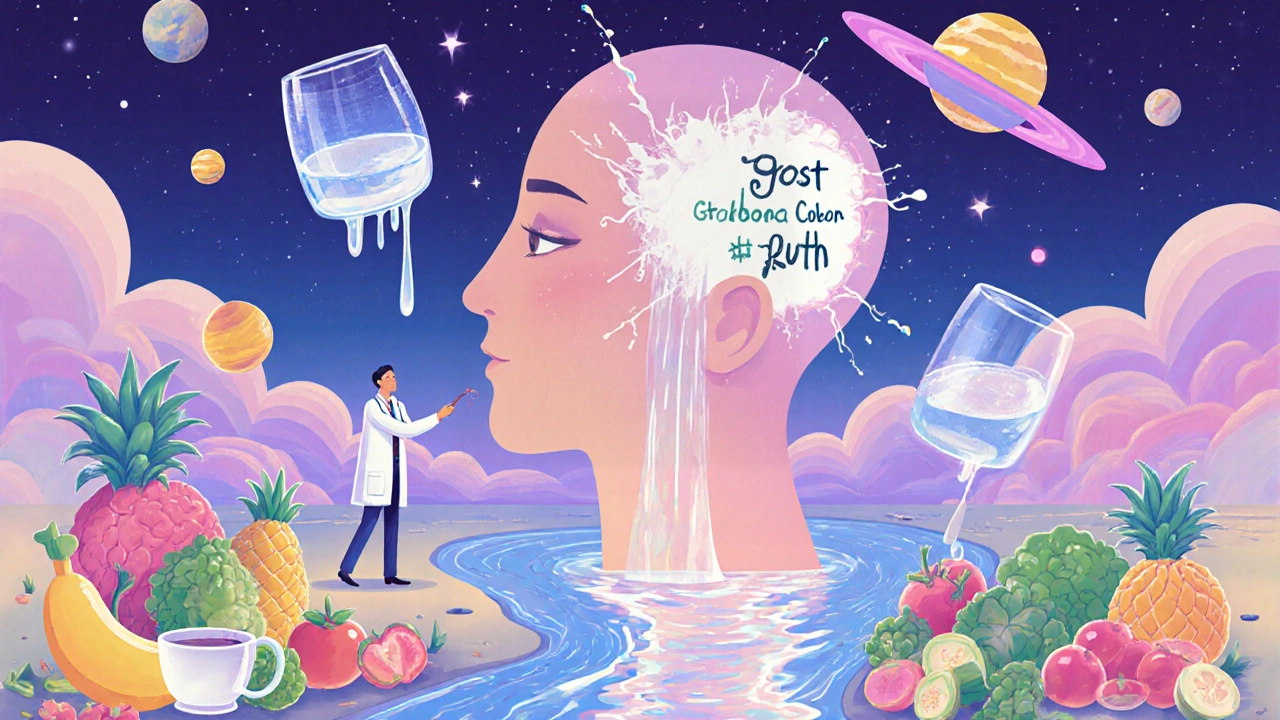
Every year, millions of people follow advice based on myths they’ve heard since childhood-myths that sound plausible, come from trusted sources, or are repeated so often they feel like truth. In healthcare, these myths don’t just cause confusion-they can lead to poor decisions, delayed care, or even harm. The good news? Most of them have been thoroughly debunked by science. The challenge? They keep coming back.
Myth: You Need to Drink Eight Glasses of Water a Day
This one’s everywhere. From school textbooks to fitness apps, you’re told to drink eight glasses of water daily to stay healthy. But there’s no scientific basis for this number. Dr. Heinz Valtin, a kidney specialist at Dartmouth Medical School, reviewed over 100 peer-reviewed studies in 2002 and found zero evidence supporting the eight-glass rule. Your body doesn’t need a fixed amount-it needs enough to replace what you lose through sweat, urine, and breathing.
Water comes from more than just your bottle. Fruits, vegetables, soups, coffee, and tea all contribute. A healthy adult in a moderate climate typically gets enough hydration through food and drink without forcing themselves to count glasses. Overhydration can even be dangerous, especially for older adults or those with kidney issues. The real signal? Thirst. If you’re not thirsty and your urine is light yellow, you’re likely fine.
Myth: You Lose 70-80% of Your Body Heat Through Your Head
This myth started with a 1950s U.S. military study where subjects wore Arctic survival gear-except their heads were exposed. Naturally, they lost a lot of heat through their heads. But that’s because their heads were the only uncovered part. If you go outside in winter wearing only a swimsuit, you’ll lose heat equally from every exposed area.
Modern research shows the head makes up about 7-10% of your total body surface area. That means it loses roughly that same percentage of heat-not 70%. Covering your head helps, but so does covering your hands, neck, or feet. The idea that your head is a special heat-loss hotspot is misleading. It’s not that your head is extra leaky-it’s that people forget to cover it.
Myth: Chewing Gum Stays in Your Stomach for Seven Years
Parents have used this one to scare kids into spitting out gum since the 1950s. The truth? Your digestive system doesn’t break down gum the way it breaks down food, but it doesn’t get stuck either. The base of chewing gum is indigestible, yes-but your gut moves it along just like any other indigestible material, like corn husks or fiber.
According to Dr. Ian Tullberg, a family medicine specialist at UCHealth, gum passes through your system in two to four days. There’s no evidence of it sticking to your stomach lining or causing blockages in healthy people. The only real risk? Swallowing large amounts of gum repeatedly in a short time, especially in young children with smaller digestive tracts. But one piece? It’s gone before you forget you chewed it.
Myth: Sugar Makes Kids Hyperactive
It’s a classic scene: a child eats candy at a birthday party, then runs around like a maniac. Parents blame sugar. But over 23 double-blind, controlled studies-including a major 2021 meta-analysis in JAMA Pediatrics-have found no link between sugar intake and increased hyperactivity in children.
So why does it feel true? Because context matters. Parties are exciting. Kids are excited. Parents expect sugar to cause chaos, so they see it even when it’s not there. This is called confirmation bias. Worse, the sugar industry spent decades funding research and lobbying to keep this myth alive, as documented in Archives of Internal Medicine in 2016. The real issue? Processed foods high in sugar often replace nutrient-dense meals, leading to poor energy regulation-not hyperactivity.
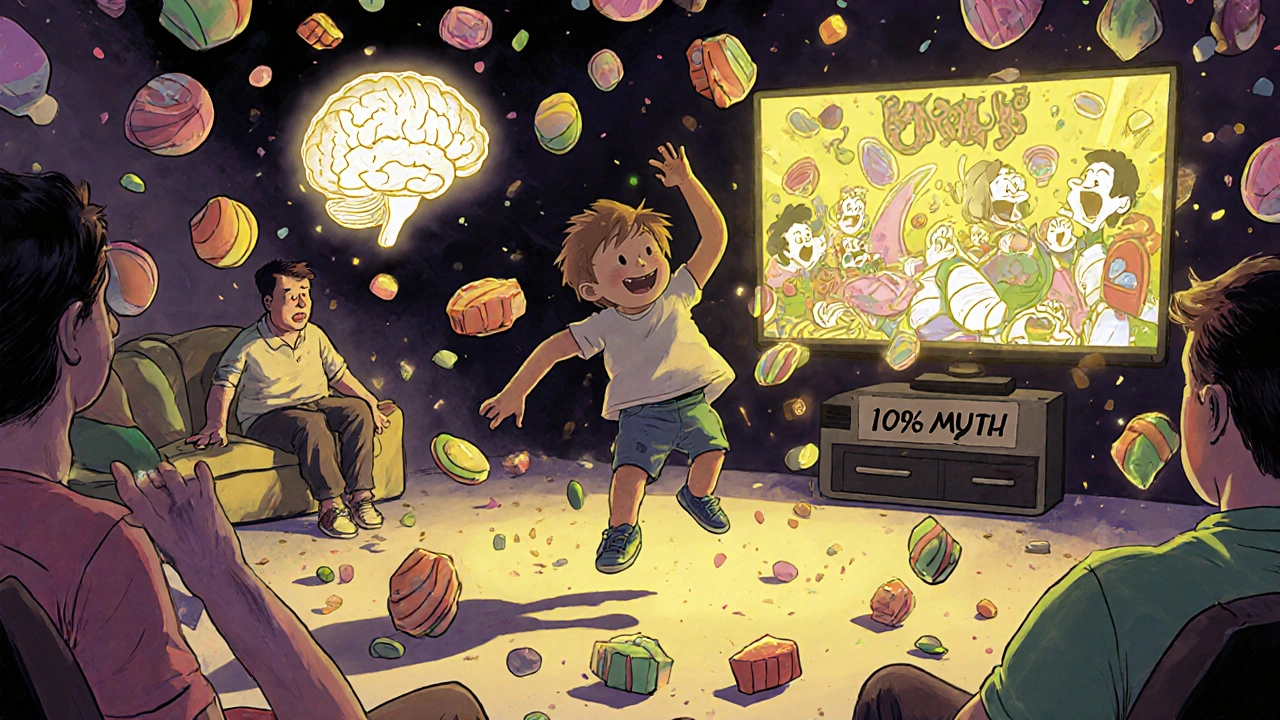
Myth: We Only Use 10% of Our Brain
This myth has been repeated in movies, ads, and self-help books for nearly a century. The idea that we’re only tapping into a fraction of our brain’s potential sounds empowering-until you look at the science.
Neuroscientists have used fMRI and PET scans for decades. These tools show that every part of the brain has a function-even during sleep. There’s no dormant 90%. Damage to almost any area causes measurable deficits. If we only used 10%, brain injuries would be far less serious. The myth likely came from a misinterpretation of psychologist William James’ writings in the 1920s, which were about untapped potential, not brain anatomy.
What’s really happening? Your brain is always active. Some areas fire more during specific tasks, but even resting, your brain uses 20% of your body’s energy. You’re using 100%-just not all at once.
Myth: Superfoods Like Acai or Goji Berries Are Miracle Cures
“Superfood” isn’t a scientific term. It’s a marketing label. Goji berries, acai bowls, chia seeds, and kale are nutritious-but they’re not magic. The European Food Information Council reviewed decades of research and found no evidence that these foods offer unique health benefits beyond what a balanced diet provides.
Blueberries, spinach, and apples have similar antioxidant levels. A bowl of acai smoothie doesn’t reverse aging or burn fat. It’s just fruit with sugar and calories. The real problem? People buy expensive superfoods thinking they’re making a health breakthrough, while ignoring basics like eating vegetables, limiting processed foods, and staying active.
There’s no single food that can fix poor habits. Nutrition isn’t about finding the next miracle ingredient-it’s about consistency, variety, and balance.
Why Do These Myths Stick Around?
It’s not just ignorance. Myths survive because they’re simple, emotionally satisfying, or tied to identity. “Sugar makes kids hyper” lets parents blame the candy, not their own routines. “Eight glasses a day” gives people a clear, easy rule to follow. “We only use 10% of our brain” makes you feel like you’ve got untapped power.
Also, myths spread faster than facts. A 2022 MIT study found that misinformation on social media spreads six times faster than corrected information. Even when people see a myth debunked, they often remember the myth more clearly-especially if the correction is poorly framed.
This is called the familiarity backfire effect. Repeating the myth-even to refute it-can make it feel more true. That’s why experts now recommend the “truth sandwich”: state the fact, briefly mention the myth with clear labeling (e.g., “Some people believe…”), then restate the fact.
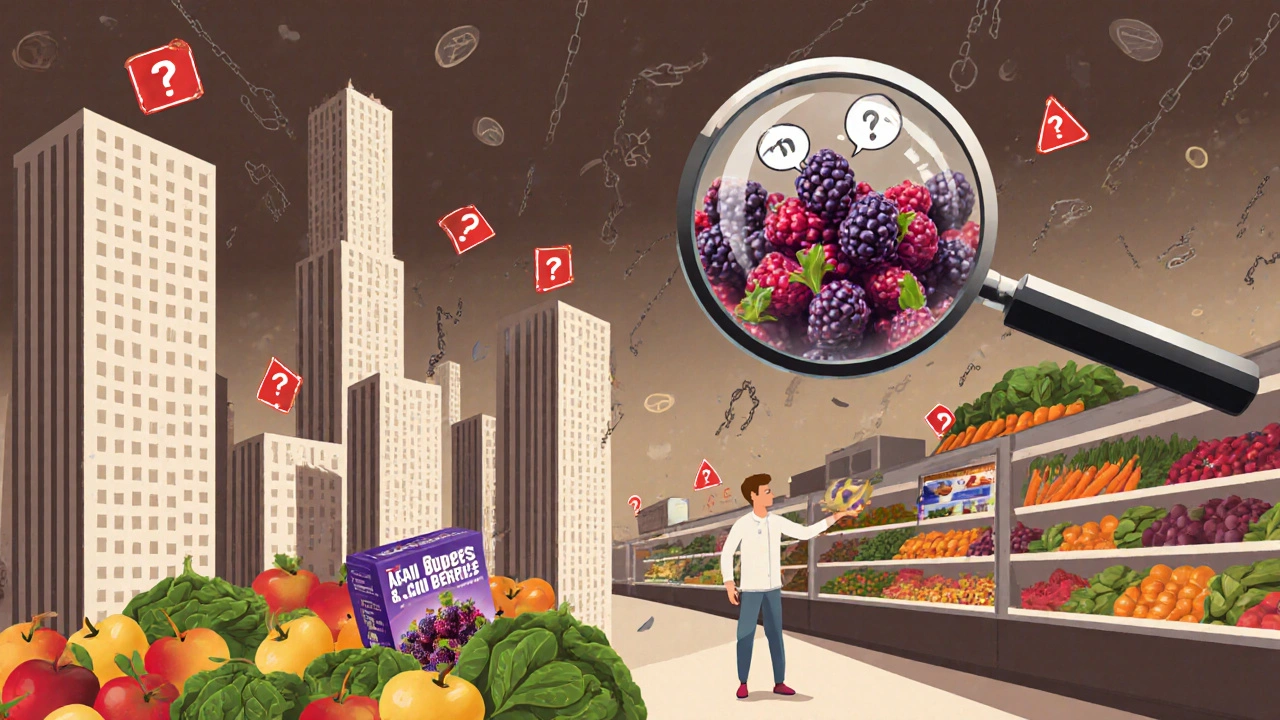
How to Spot and Fight Health Myths
Not every myth is dangerous, but when it comes to health, even small misunderstandings can add up. Here’s how to tell fact from fiction:
- Check the source. Is it a university, government health agency (like CDC or WHO), or peer-reviewed journal? Or is it a blog, influencer, or product ad?
- Look for evidence. Does it cite studies? Are those studies real and recent? A single anecdote isn’t proof.
- Ask: “Who benefits?” If a product claims to “cure” something with a miracle ingredient, it’s likely selling you something.
- Be wary of absolutes. “Always,” “never,” “everyone,” “the only way”-these are red flags. Biology is rarely that simple.
When in doubt, talk to your doctor or pharmacist. They’re trained to separate myths from medical facts-and they’ve heard them all before.
What’s Changing in Patient Education?
Healthcare institutions are finally catching on. In 2023, 68 U.S. hospitals added myth-busting sections to their patient education materials-up from just 12 in 2020. The American Hospital Association says patients who get myth corrections are 31% more likely to follow treatment plans.
Organizations like the WHO’s Myth Busters initiative have corrected over 2,300 myths in 187 countries. Google now shows “About This Result” boxes next to search results, pulling in fact-checks from trusted sources. And AI tools like MIT’s TruthGuard are being tested to predict new myths before they go viral.
The goal isn’t to shame people for believing myths. It’s to make accurate information easy to find, understand, and trust.
Final Thought: Knowledge Is a Habit, Not a One-Time Fix
Debunking a myth once doesn’t erase it from someone’s mind. Research shows it takes 3 to 5 exposures to the correct information, in different contexts, before a belief truly shifts. That’s why patient education needs to be ongoing-not just a pamphlet at the clinic.
Ask questions. Double-check claims. Share corrections kindly. The most powerful tool against myths isn’t a fancy app or a viral video-it’s a curious, skeptical, and informed mindset.
Is it true that you need to drink eight glasses of water every day?
No, there’s no scientific evidence supporting the eight-glass rule. Hydration needs vary by person, activity level, climate, and diet. Water comes from food and other drinks too. Thirst and light yellow urine are better indicators than counting glasses.
Does chewing gum stay in your stomach for seven years?
No. While your body can’t digest the gum base, it passes through your digestive system in two to four days, just like other indigestible materials. It doesn’t stick to your stomach or intestines unless swallowed in very large amounts over time.
Can sugar cause hyperactivity in children?
No. More than 20 controlled studies, including a 2021 meta-analysis in JAMA Pediatrics, found no link between sugar intake and hyperactivity. The belief persists due to cultural expectations and confirmation bias-not science.
Do we only use 10% of our brain?
No. Modern brain imaging shows all parts of the brain are active at different times. Even during rest, your brain uses significant energy. The 10% myth is a misunderstanding from outdated psychology and has been thoroughly disproven by neuroscience.
Are superfoods like acai or goji berries better than regular fruits and vegetables?
No. “Superfood” is a marketing term, not a scientific one. Acai and goji berries are nutritious, but they don’t offer unique benefits that can’t be found in common foods like blueberries, spinach, or apples. A balanced diet is more effective than any single “miracle” food.
Why do health myths spread so easily?
Myths stick because they’re simple, emotionally satisfying, or confirm what people already believe. They spread faster than facts online, especially when tied to identity, culture, or profit. Even debunking can backfire if done poorly-repeating the myth without clear labeling can reinforce it.
How can I tell if a health claim is true?
Check the source: Is it a university, government agency, or peer-reviewed journal? Look for citations, not anecdotes. Be skeptical of absolute claims (“always,” “never,” “miracle cure”). If a product is being sold, ask: Who benefits? When in doubt, talk to a healthcare professional.

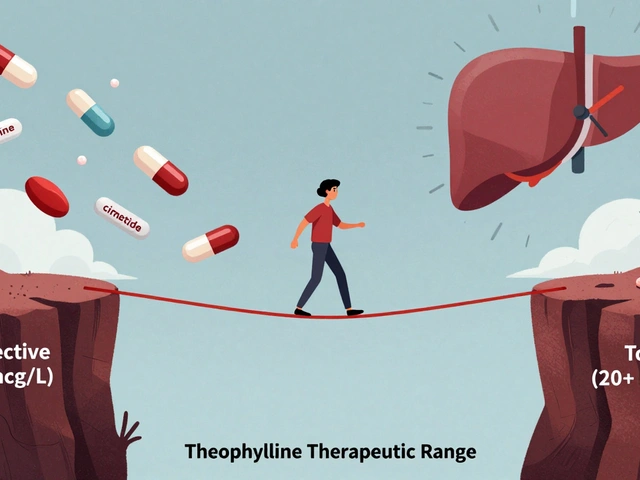
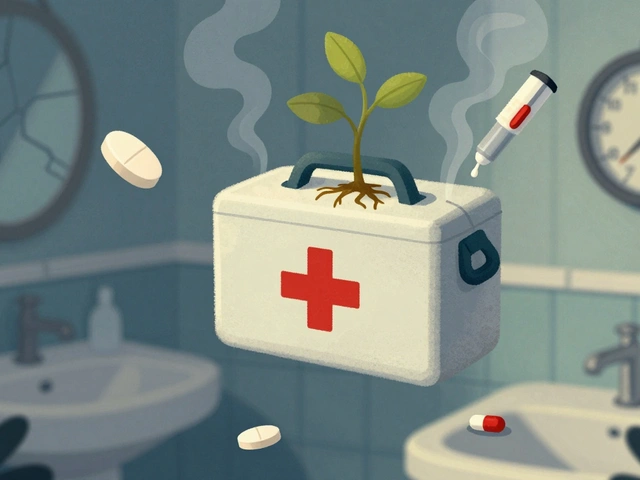

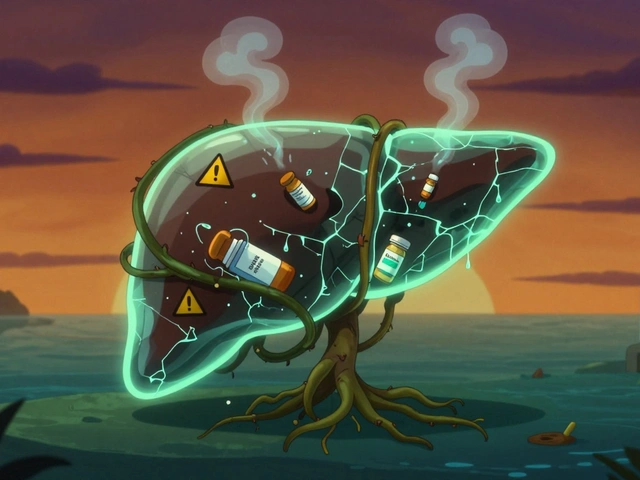
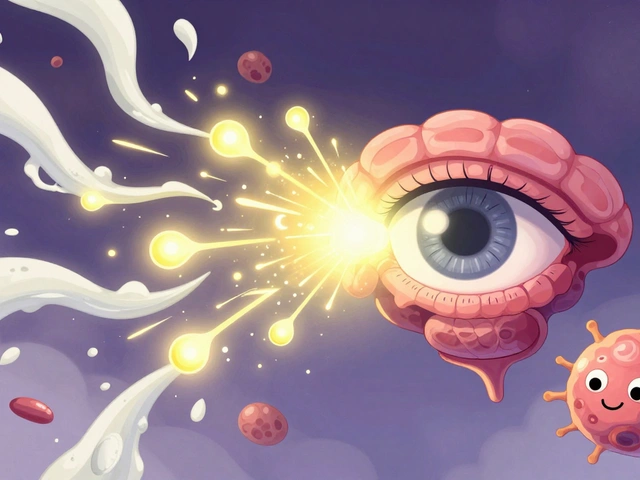
11 Comments
i read this and immediately thought about my mom who still swears she needs 8 glasses of water or she'll 'dry up'... like ma'am, you drink tea, eat watermelon, and sweat like a pig in yoga-your body knows.
/p>also, i typoed 'watermellon' just now. oops.
Thank you for this. So many people stress over arbitrary rules. Thirst is a perfectly reliable signal.
/p>The hydration paradigm shift is clinically significant. The homeostatic regulation of fluid volume is mediated by osmoreceptors in the hypothalamus, not arbitrary volumetric thresholds. The eight-glass heuristic is a population-level approximation with negligible individual predictive validity.
/p>Moreover, dietary water contribution varies by macronutrient composition-particularly in high-fiber, high-protein diets where endogenous water yield increases.
It is astonishing that such elementary scientific misconceptions persist in the public consciousness. One would assume that basic physiology, taught in high school biology, would be common knowledge by now. The fact that we still need to debunk these myths speaks to a systemic failure in science communication.
/p>YAS. 🙌
/p>Also, sugar doesn't make kids hyper-parties do. And also, your aunt’s ‘miracle acai bowl’ is just blended fruit with a $12 price tag and a side of guilt. 😏
Keep debunking, heroes. 🌟
Why are we still talking about this? This is 2024. People are still swallowing this nonsense? The fact that this even needs to be written is a national embarrassment. Someone’s making money off this. Who? Why aren’t we investigating?
/p>Interesting. The 10% brain myth is perpetuated by self-help gurus who profit from selling ‘unlock your potential’ courses. The sugar-hyperactivity myth correlates strongly with socioeconomic status-lower-income families are more likely to believe it because they lack access to peer-reviewed literature. The real issue isn’t the myth-it’s the information asymmetry.
/p>Let’s be real-the ‘eight glasses’ myth was probably invented by a water bottle company in the 90s who needed a catchy slogan.
/p>And the ‘head loses 70% heat’ thing? That’s not just wrong-it’s a *dramatic* misrepresentation of physics, dressed up as survival wisdom. It’s the kind of myth that makes you feel like you’re in a National Geographic documentary when you’re just trying to get to your car in December.
Meanwhile, the ‘superfood’ industry is basically selling glitter in a bowl and calling it ‘antioxidant alchemy.’
It’s not that people are dumb. It’s that they’re tired. They want simple answers to complex systems. And capitalism? Oh, it’s *flourishing* on that exhaustion.
So yes, we need better communication. But also-we need to stop pretending that every myth is just a ‘mistake.’ Some are *designed* to sell.
While I appreciate the attempt at demystification, I must point out that the author has failed to cite the 2018 NIH longitudinal study on renal adaptation to fluid intake variability, which clearly demonstrates that habitual underhydration-despite absence of thirst-leads to subclinical tubular stress in 63% of asymptomatic adults. Furthermore, the assertion that ‘thirst is sufficient’ is dangerously reductive, especially in geriatric populations where thirst sensation is diminished due to age-related downregulation of angiotensin II receptors. One cannot rely on subjective sensation when objective biomarkers exist. This article, while well-intentioned, dangerously oversimplifies a nuanced physiological process. I have written to the journal to request a correction.
/p>Who funded this? The water industry? Big Pharma? The fact that they’re pushing ‘thirst is enough’ while simultaneously selling electrolyte drinks and IV hydration services is no coincidence. The CDC has been quietly reclassifying dehydration as a ‘lifestyle choice’ since 2021. Don’t be fooled. They want you to believe you’re fine so they don’t have to pay for your kidney failure.
/p>Look, I get it. You want to feel smart by debunking myths. But let’s not pretend that science is some pure, objective force untainted by institutional bias. The ‘eight glasses’ myth was debunked by a guy who worked for a bottled water company’s advisory board. The ‘head heat loss’ myth was corrected by researchers funded by the outdoor apparel industry. The ‘sugar doesn’t cause hyperactivity’ studies? Mostly funded by sugar lobbyists. And now we’re supposed to trust the same system that spent decades denying climate change, smoking risks, and vaccine links? The real myth here is that science is neutral. It’s not. It’s a market. And you’re just another consumer being sold the ‘correct’ version of the truth-because someone, somewhere, is profiting from you believing it. So go ahead. Drink your tap water. Eat your kale. Believe the ‘facts.’ Just don’t pretend you’re not being manipulated. You are. And so am I. We’re all just trying to survive the noise.
/p>